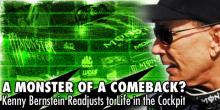 There are some things,
There are some things,
like riding a bike or tying a shoe, which you never forget how to do. Is
driving a Funny Car one of them?
Kenny Bernstein certainly
hopes so.
The NHRA legend, who made
his name in the nitro-coupe class during the 1980s before retiring in 2002 as a
two-time Top Fuel champion, is returning to the driver's seat this season,
piloting the Monster Energy Dodge Charger Funny Car, beginning with this
weekend's 47th CARQUEST Auto Parts Winternationals in Pomona, Calif.
Bernstein, one of only
three drivers to score at least four Funny Car championships, hasn't driven a
fuel “flopper” since leaving the class after the 1989 season, but he is
expecting a smooth transition.
